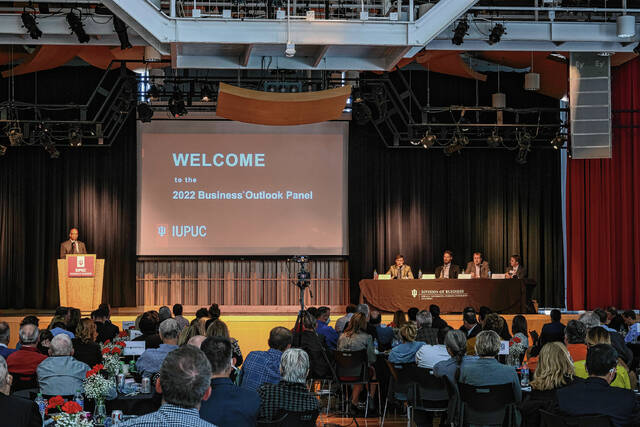
Kevin Jones, far left, associate professor of management at IUPUC, moderates as panelists Andrew Butters, at table from left, Ryan Brewer, Kyle Anderson and Steven Mohler answer questions during the 2022 Indiana Business Outlook Panel at The Commons in Columbus, Ind., Monday, Nov. 8, 2021. Mike Wolanin | The Republic
IUPUC and Indiana University business experts predict that while certain economic difficulties and uncertainties are likely to continue in 2022, the year may hold some hope of economic progress, particularly if the COVID-19 pandemic does not worsen.
As Columbus Area Chamber of Commerce President Cindy Frey put it, “There are some storm clouds brewing, but I hope we leave here feeling a sense of cautious optimism.”
Frey’s words capped off the annual Indiana Business Outlook Panel at The Commons in downtown Columbus on Monday. The event was co-hosted by the Chamber of Commerce, the Indiana University Division of Business, the Kelley School of Business and the Indiana Business Research Center.
Since 1972, experts from the center, which is a part of the Kelley School of Business, compile, analyze, and interpret international, national, state and local economic data and prepare predictions for the coming year. These forecasts are presented at various communities around the state. The Columbus event is a primary fundraiser raising money for scholarships for IUPUC business students.
This year’s panelists had some positive predictions for the new year, though these were tempered by concerns regarding supply chain issues, loss of labor force, the effects of the pandemic and a continuing sense of uncertainty for what the future might hold.
“There may have never been an economic forecast as difficult to put together as the one for this year,” said IUPUC Vice Chancellor and Dean Reinhold Hill at the beginning of Monday’s event.
The first presentation came from Andrew Butters, associate professor in the Kelley School of Business at Indiana University, who spoke on the national and international forecasts for 2022. Butters said that economic predictions in both cases involve “quite a bit of uncertainty,” though perhaps not as much as last year.
The situation regarding COVID-19 will have an impact on global recovery, he said, adding, “as the pandemic goes, so does the economy.”
There are “systematic differences” in regards to vaccine access, with vaccination rates in low-income countries lagging significantly behind that of the “advanced world population.”
Butters predicted “robust” global economic growth of 4.9% but added that low-income countries are differing significantly from the rest of the world and “could struggle to regain even their pre-pandemic living standards.” The expected growth rate for the U.S. economy is between 4% and 5%, he said.
The financial markets
Following Butters, Ryan Brewer presented an outlook on financial markets. Brewer is an associate professor of finance and leads the Indiana University Division of Business in Columbus.
He also pointed to the impact of COVID-19 on economic outlooks, particularly in regards to the “inefficiencies of restarting an entire economy after the world shut down due to the pandemic.”
“So what’s the forecast for 2022 for the financial markets?” he said. “It all starts with COVID, and COVID looks like it’s on a good track to run its course by the end of 2022 if vaccination rates keep rising. And if we do get that effective oral treatment, that would be also a shot in the arm for the economy.”
The Associated Press has reported Merck’s COVID-19 pill is already under review by the U.S. Food and Drug Administration. The United Kingdom approved it for adults age 18 and older who have tested positive for COVID-19 and have at least one risk factor for developing severe disease, such as obesity or heart disease.
Brewer also noted that the pandemic has had an effect on the labor force. While unemployment is at 4.6% and dropping, labor force participation is down.
“The market is missing 3.5 million workers and importantly, 3.8 million workers are not working because their employer closed their doors during the pandemic or they lost business because of the pandemic,” he said.
According to Brewer, another major factor in the future is inflation, and whether it will be temporary or “persistent.” Overall prices are up 5.4% year over year, he said. The core Consumer Price Index, which excludes food and energy, is up 4%. New vehicles are up 8.7% compared to one year ago, and used cars are up 30% to 45%. Commodities are higher “across several measures.”
“(Federal Reserve Chair) Jerome Powell does believe that inflation is transitory, which leads us to believe that he’s going to be less aggressive with tapering,” Brewer said.
Powell, whose term ends in February, is comfortable with inflation above 2% for some time, though the long-term goal is still “anchored” to 2%, he said.
Brewer expects inflation to continue “significantly above 2% well into 2022” and then start to slow toward the year’s end. He also expressed hope that supply chain efficiencies would “normalize” by the end of 2022.
“So where would you want to put your money if you were going to invest in financial markets?” Brewer said. “If you believe that we’re going to have sticky inflation for a while, you might go commodities, because anything dollar-denominated should prove to fare pretty well in the future.”
Different perspectives
When it comes to the future of Indiana’s economy, panelist Kyle Anderson had a mostly positive outlook, though he noted that there are “so many different perspectives on where the economy’s headed.” Anderson is a clinical assistant professor of business economics at the Kelley School of Business in Indianapolis.
There are a number of good indicators for the state, he said. Unemployment in Indiana is at 4%, and wages are rising. However, he noted that the state has problems with not enough workers similar to those of the country as a whole.
“We’ve had 60,000 workers who have left the labor force since early 2020,” he said. “And we often get asked, ‘Well, what happened to them?’ And there’s no one answer.”
Some workers have opted for retirement, he said. Others are out due COVID-related factors — such as having had it, caring for a family member who has it, or taking care of school-age children during this time. Anderson concluded that a variety of factors means that it’s hard to say when these individuals might return to the workforce.
He predicted that some will not come back, but hopefully as there is “continued progress with COVID,” there will be increases in labor force participation for both Indiana and the country.
Anderson added that he believes that a temporary labor shortage actually could be a good thing in the long run, as it will encourage businesses to increase their investment and “labor productivity.” Over time, this should lead to increased wages without the burden of increased prices.
The state is facing other challenges as well. Anderson noted that “a lot of what still drives Indiana is manufacturing,” so supply chain disruptions are affecting Indiana “pretty severely.”
These difficulties are likely to continue, but it’s been a subject of major debate whether this will work itself out over three to six months or two years. Infrastructure needed to help port challenges will definitely take years. However, experts are hopeful that other pieces of the puzzle might be resolved much sooner than that.
Anderson concluded that while the state faces “risk and challenges, he expects moderate growth in 2022.
Wages in state lagging
“Indiana still lags in overall wages, lags in investment in education, but what we’re seeing in terms of manufacturing and distribution mean that the overall forecast for Indiana is pretty positive for 2022,” Anderson said.
Columbus, as a manufacturing hub, faces similar challenges to the state, said Steven Mohler, assistant professor of management at IUPUC, in his local forecast. More than 50% of the city’s gross domestic product (GDP) is based on manufacturing, and more than 37% of the local labor force is in that same industry. Also, 12% is in government and 7% is in hospitality.
He noted that robust consumer spending has “depleted new vehicle inventories, which have not been replenished due to supply chain issues and chip issues.”
According to Mohler, a major factor in supply chain challenges is a shortage of trucks and truck drivers. He cited American Trucking Associations Chief Economist Bob Costello and said that the country needs “80,000 more truck drivers than are currently in the workforce.”
“The truck driver shortage problem has been listed as the number one issue facing the trucking industry for the last five years,” Mohler said. “While there are no simple solutions to today’s problems, a key takeaway regarding our supply chain lows is the problem did not come about overnight and will not be solved overnight.”
In giving his 2022 predictions for Columbus, Mohler said he expects the local GDP to be “erratic.” The three-year change to GDP has been similar to that of Bloomington, Cincinnati and Indianapolis.
“Although the MSA GDP numbers for 2020 will not be published until next month, December, based on Indiana GDP, we anticipate a sharp decline for Columbus for 2020, and a modest increase in 2021,” Mohler said. “…The forecast for the Columbus 2022 GDP is a 5% to 6% percent growth rate, somewhat typical of a recovery year.”
However, he added that uncertainty from the supply chain, government and pandemic “may have an unknown impact on the numbers you are given.”
“Quite an understatement, we live in a chaotic world,” he said.




